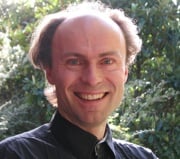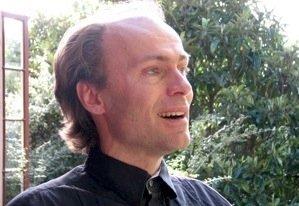“All we conductors have a vision of how the music should sound ideally,” he says on the patio of the near idyllic, precariously perched Berkeley hills rental he shares with his cellist wife and children. “How the voices should sound individually and together, when it’s in tune, and most importantly, how the phrasing should be.

Photo by Jason Victor Serinus
"You have this vision inside, and this feeling of the energy that you think can be accumulated and extracted out of the music when you do all those things right, and put all your emotions and understanding of the text into singing.
“They should all merge into one product; that’s the ideal, the goal. And when you have that vision inside, whatever group you have in front of you, you work towards that inner vision. That’s why I’m never frustrated with whatever level I’m working at, as long as we’re moving closer to that vision. It’s almost more rewarding to work with a group that starts on an elementary level and progresses, than start with a group that is quite advanced and you cannot take them anywhere for some reason or another.”
Thirty-seven months after he moved to San Francisco to conduct the splendid chorus that was long associated with Vance George, Bohlin gets a major opportunity to share the a cappella Swedish repertoire close to his heart. One of the pieces, Ingvar Lidholm’s … ariveder le stele, is arguably one of the major 20th-century Swedish a cappella works.
It was also performed here under George “way, way back.” So much for any preconception that only the former choirmaster of Stockholm’s Maria Magdalena Church and student of Swedish tenor Nicolai Gedda and choir director Eric Ericson would devote the first half of the chorus’ afternoon to spotlight Swedish repertoire.
Another work on the program, Lars Edlund’s Tvenne Folkvisor (Two folksongs), reminds us of Scandinavia’s rich musical history. “Forgive me, Jean Sibelius and Wilhelm Stenhammar,” Edlund wrote on the front page of the score.
“It’s sort of a rip-off of Sibelius’ tonal language,” Bohlin confesses. “But they’re very lush and beautiful arrangements of two folk songs.” As in, how could I resist? Nor could Bohlin resist commissioning a San Francisco Symphony world premiere, Fredrik Sixten’s Let There Be. “I bought the pig in the sack, as we say in Sweden,” says Bohlin with glowing eyes. “It was only completed about a month ago.
“I know Sixten. I have conducted a few of his big pieces, a St. Mark’s Passion and a Requiem, and have recorded some of his a cappella pieces. He’s a young, strongly up and coming guy, and I do like his music a lot. It’s very direct. He deliberately composes accessibly so that the listener can understand it immediately. I admire him, because I think he can do that without getting vulgar or common; he always finds something fresh.”
After one of the few 19th-century Swedish choral pieces that remains in the active repertoire, Ludwig Norman’s Jordens oro viker, and Sven-Eric Johanson’s Fancies II, a fresh take on Shakespeare, the chorus will journey to Russi, for the first half of Rachmaninov’s Vespers, Op. 37. Listen for the bass descent to B-flat.
“I’m blessed with five basses, maybe six, who have that B-flat most of the time,” Bohlin quips. “I have to tell them to take a good Scotch or Vodka the night before.” Maybe the rest of the bass section is in recovery.
The concert ends with the rousing “small version” of Bernstein’s Chichester Psalms for organ, percussion, harp, and chorus. Bernstein called it “the most B-flat majorish tonal piece I’ve ever written.” Expect the 120 volunteer and 30 professional members of the San Francisco Symphony Chorus to drive the Bible via the Bronx score home like nobody’s business.

